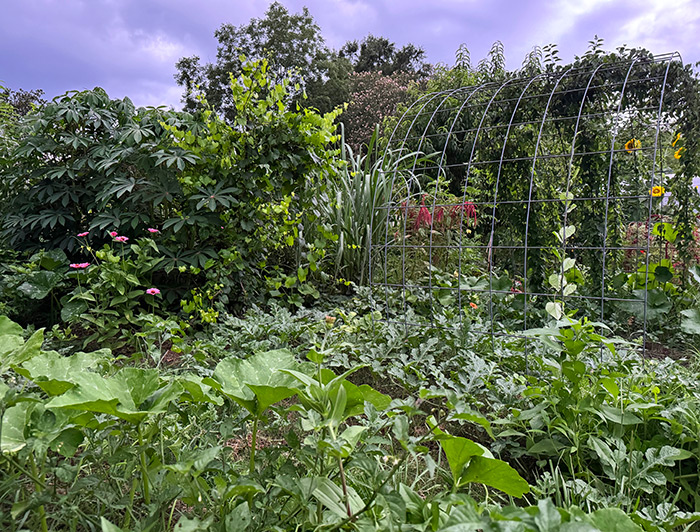Use these monthly tips to care for your poinsettia year-round and get it to rebloom. The flowers, which are actually bracts or modified leaves, may return to their beautiful pinks, reds, or whites, with the right care.
For more on popular houseplants, see How to Grow Orchids which includes my mom’s top tips for growing her favorite flowering plants.

How to Grow Poinsettias Indoors Year-Round

With over 34 million poinsettia plants ($153M) sold each year, it’s rather heartbreaking to imagine how many of those potted flowers are tossed in the trash bin when the holidays are over.
Because poinsettias are not frost hardy and do not tolerate temperatures below 50°F (10°C), our only option in a cold climate is to grow them indoors as houseplants.
Fortunately, like Christmas cactus, poinsettias can last for years with the right care. Reblooming is possible but takes extra effort.
Making Poinsettias Bloom Again
Getting poinsettias to rebloom is part of a long process starting after a rest period.
While getting a poinsettia to flower again—or, really, getting the modified leaves (bracts) to change color—is possible, it’s best to manage your expectations.
Even when you follow the instructions (below) with precision, some poinsettias will not change color again. But, when it works, it’s so rewarding.
The tips below walk through year-round care and reblooming tips month by month.
Contents
About Poinsettias
History of Poinsettias
It’s always helpful to know the origin of a plant to better understand what it needs.
Poinsettias (Euphorbia pulcherrima), also known as Christmas star, are indigenous to Mexico. They grow as shrubs, reaching heights of 12-feet tall, with the familiar red and green foliage and tiny yellow bud-like flowers.
Holiday Plants
The version of poinsettias we see mass produced for holiday sales started with a grafting trick developed one hundred years ago. This made it possible to grow them as compact, bushy plants in containers.
A poinsettia’s true nature becomes apparent as we grow them as houseplants after the holiday season and the dwarfing chemicals used in greenhouses wear off. The stems start to become leggy and tall, just like their ancestors were, and some pruning is needed to keep them looking compact and full.
With over 100 cultivated varieties, poinsettias come in all sorts of colors including the traditional red, apricot, salmon pink, orange, yellow, cream, and white. There are also plenty of multi-hued, marbled, and speckled variations.
You may also notice unusual blue, purple, and sparkly silver ones in shops: those are dyed and glittered, and, well, perhaps not really suitable for those of us who like some nature in our plants.
Related: What is Plant Grafting?
Poinsettia Flowers

The true flower of a poinsettia is actually only the tightly-clustered yellow buds in the center (termed ‘cyathia’). The surrounding leaves that change color are modified leaves called bracts. The rest of the plant has dense, green leaves.
Poinsettias as Houseplants
Poinsettias do not tolerate temperature swings. When buying one, keep it completely protected on its journey home from the store.
What makes poinsettias different than some other tropical houseplants is their intolerance for temperature swings, drafty conditions, and soggy soil.
They do best with even conditions (60-70°F | 15-21°C) with diffused sunlight six hours a day, and the potting soil on the drier side, but never dried out.
If temperatures go below 50°F (10°C), it can be game over.
We know the plant was shocked when the leaves start to wither and die—not just post-Christmas leaf drop, but everything is down for the count.
But I’m here to encourage you to grow them, not scare you off, so let’s keep going. You’ve got this.
Related:
How to Grow Christmas & Thanksgiving Cactus
If you’re going on vacation, use these tips for keeping plants watered while you’re away.
How to Choose a Healthy Plants
When buying a poinsettia, these tips will help you choose the healthiest plant with the best chance of a long life.
- Healthy appearance | The plant should have an overall healthy and robust appearance: no dying, yellowing, or fading leaves or other signs of distress.
- Tight yellow buds | The flowers (yellow buds in middle of leaves) should be tight, not open, or spilling pollen.
- Room temperature (or warmer) container | Check the temperature of the container with your hands. It should be room temperature and not cold. Some poinsettias are (wrongfully) kept refrigerated prior to display in stores.
- No breezes | Avoid plant displays by the front of the store where automatic doors are letting bursts of cold air in. The plant may look okay today, but a week from now it may die off.
- Moist potting mix | Put your fingertip in the potting soil to check the moisture level. You don’t want soggy soil, nor should it be so dry that the soil is shrinking back from the inner sides of the pot.
- Bug-free | Check under leaves for insects, eggs, or signs of munching. Let no buggy plants come home with you!
When you’ve picked the best plant, it must be completely covered for the ride home to avoid exposure to wind and cold temperatures.
There’s a honeymoon period of about 6 to 8 weeks where your poinsettia will look fabulous and require minimal care.
Follow the watering tips below and keep away from cold drafts.
Year-Round Care Tips Including Reblooming
Safety Tip
Poinsettias have sap that can causes skin sensitivities or allergies. For this reason it is recommended that you wear gloves when handling your plant.
How to Water
- When you buy your plant, remove the decorative foil wrapper, or make holes in it to allow excess water to freely drain out of the pot into a saucer.
- In a heated home with moderate humidity (around 50% is good), watering may be need around 1x a week or a bit sooner.
- Finger test! Water when the potting mix is dry to touch (one knuckle deep). Or use a moisture meter. I like them for a simple yes or no answer and ignore the other readings.
- Water enough to reach the roots. Empty any excess water that collects in pot saucer.
- Never allow the soil to dry out, but never let it stay soggy either.
This shares a simple way to tag your houseplants to know their water and light preferences at a glance.
Monthly Care
I’ll walk you through a year of poinsettia care. The first half of the year is basic care. Then we take steps to encourage the plant to go into color once again (“flower”) for the next holiday season.
These milestones may not happen right on schedule, but you’ll get the idea of what to expect.
January to March
- As your poinsettia starts to look a little tired, we begin its first year as a houseplant.
- Provide six hours a day of diffused sun and water lightly when the soil is dry to touch.
- Don’t freak out if leaves drop or shrivel. It may be just recovering from the intense conditions that made it so pretty for the holidays.
- The next few months are a rest period.
April
- When new growth appears, you can begin fertilizing. I use liquid fish fertilizer (following the directions on the container) but you can use any general fertilizer made for indoor plants and follow the instructions on the product label.
- If there are dead flowers or bracts, you can pinch those off.
May
- It may be time to repot the plant to a container one size up. Use potting mix made for indoor flowering plants.
- Some time between May and July, your poinsettia may be ready for pruning. This part takes courage!
- Using clean tools, cut back stems to approximately 4-inches tall—some gardeners go down to as little as two-inches—cutting just above leaf nodes (those bumpy parts on the stems where stems and leaves grow from).
June to August
- When outdoor temperatures are consistently over 55°F (12°C), you can grow your poinsettia outdoors for the summer months (or just keep it indoors).
- Indoors or outdoors, place your poinsettia in indirect light to avoid sunburn and never let it dry out.
- Continue watering as before, waiting until potting soil is dry to touch, and never soaking or starving the plant.
- I like to use half-strength fertilizer in the water all the time, rather than remembering to give full-strength periodically.
- The plant should start to regenerate during this phase, sending up new shoots and leaves.
- If it gets leggy, prune as needed, and wear gloves to avoid contact with the sap which can be irritating.
September
How to Make Poinsettias Rebloom
October and November
This is the part that takes some dedication to see it through.
I set daily reminders on my phone because you have two simple tasks to do every day, as you’ll see.
For this next stage, we’re going to alternate between periods of light and total darkness every single day for 6 to 8 weeks.
- Daytime: keep your poinsettia in the sunniest location you have.
- Nighttime: provide complete uninterrupted darkness for 12 to 15 hours a day (whatever fits your schedule).
The easiest way to do this is to find a cardboard box large enough to set over the plant each night so zero light gets in.
The box is removed each morning.
Continue watering and fertilizing as usual during this time.
Color Change
Some time during this phase, you may notice buds (cyathia) forming or yellowing, and their surrounding leaves (bracts) gradually changing colour.
Some people notice this as early as two weeks in.
Keep going until your poinsettia has transformed.
Not to be a Debbie Downer, but, as mentioned, some poinsettias won’t produce their original colors again, and others will change only slightly, but nothing compared to their original show.
You can decide if it’s still a worthwhile houseplant or if it’s time to compost it.
Best case scenario, over the 6 to 8-week period, the buds turn yellow and the bracts turn red, pink, white—or whatever they shall be, and you get to enjoy the blooming phase all over again.
Pests and Diseases
- Poinsettias are susceptible to fungal, bacterial, and parasitic diseases.
- Overwatering can kill a poinsettia or cause grey mold to form.
- A weakness in the plant or life outdoors can also attract mealybugs, whiteflies, and scale insect.
- If a pest problem arises indoors, if serious, I usually dispose of a plant rather than trying to treat it to avoid affecting my other plants. Life is just too short sometimes to fuss with these things.
Frequently Asked Questions
Poinsettias are not poisonous the way we have been led to believe. As part of the Euphorbiaceae or spurge family including rubber trees that produce latex, poinsettias produce a milky sap which some people are either sensitive or allergic to. If handling the plant, use gloves to prevent skin or eye irritation.
As for the rumors of poinsettia being wickedly poisonous or toxic, it is not so. Studies show they are not the dangerous plants we once thought they were. Poinsettias are bitter tasting—which is good because this helps prevent ingestion—and research shows it would take a huge quantity to cause problems. That said, if you have pets—cats, dogs, rabbits, or kids inclined to try these things, keep the plants out of reach.
Read more: Poinsettias Are Not Toxic | Ohio State University
Yes, you can grow potted poinsettias indoors like other houseplants. Provide full, diffused sun, water lightly, and prune (with gloves on) if the plant becomes leggy.
If you want your poinsettia to bloom (change color) again, follow the instructions above.
You cannot make a poinsettias leaves remain red indefinitely. When a poinsettia has red leaves, it’s in a flowering stage which last several weeks and sometimes months. After that, the plant needs a rest period where it can build up energy to (we hope) bloom once again.
While you cannot force the leaves to stay red (or whatever color they were ) continually, you can provide the right conditions to encourage a repeat performance as described above.
Generally, we cut back or prune a poinsettia in late spring when the plant is finishing up its rest period.
Using clean pruners or fine snippers, working one stem at a time, cutting each one back to approximately four-inches, just above a leaf node.
Always wear gloves because poinsettias ooze sap that is irritating to skin and eyes.
See the videos (below) for more pruning tips.
Poinsettias are tender, tropical perennials, so, theoretically, if you provide the right conditions indoors (explained in full above), and never expose the plant to temperature swings or shock it, it could last for many years.
I remember my mother keeping them as houseplants, but I don’t think she pruned them because they tended to be leggy. But they kept on going.
Reviving a poinsettia is a gradually process. If the plant was shocked, either by temperature swings, overwatering or underwatering, or wind (which dries out plants), it may be too late.
You can try pruning away any dead or dying parts, place it in a draft-free sunny location, and water only when the soil is dry to touch.
Sometimes they drop foliage after blooming, other times they are giving up the ghost.
You’ll know in a month or two if it’s toast or there is new life ready to spring back.
You cannot make a red or pink poinsettia turn white. Poinsettias are bred in different colors. If you want a white one, you get a white one. A red poinsettia, for example, cannot be forced to turn white.
That said, insufficient light can produce faded versions of the original colors.
Yes, you can grow poinsettias from cuttings. First, be sure that the plant is not patent protected so you know it is legal to do so.
Take cuttings from new growth, not stems that have flowered already. You want them at least 3-inches long with mature leaves and follow these instructions for propagating softwood cuttings.
Resources
Watch Poinsettia Growing Tips
Listen
Read More
I hope you’ll try growing your poinsettia year-round.
But, if you decide not to, add it to the compost pile and reuse the pot. It’s the least we can do to make the gardening world a little greener.
~Melissa the Empress of Dirt ♛






